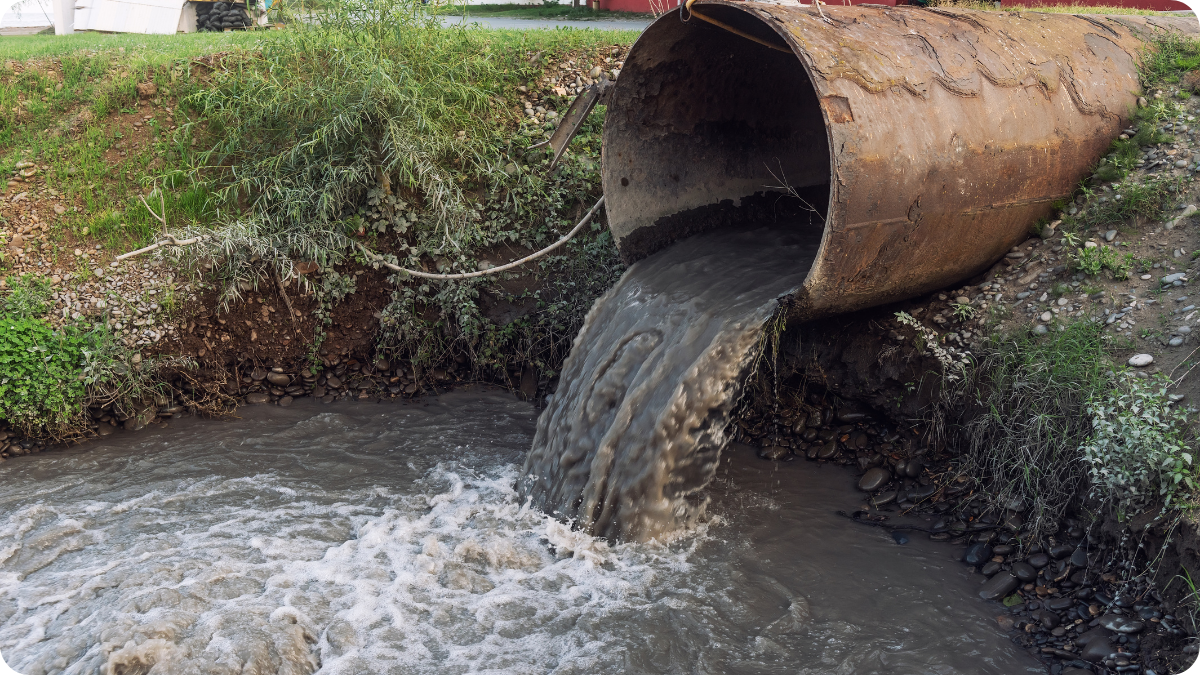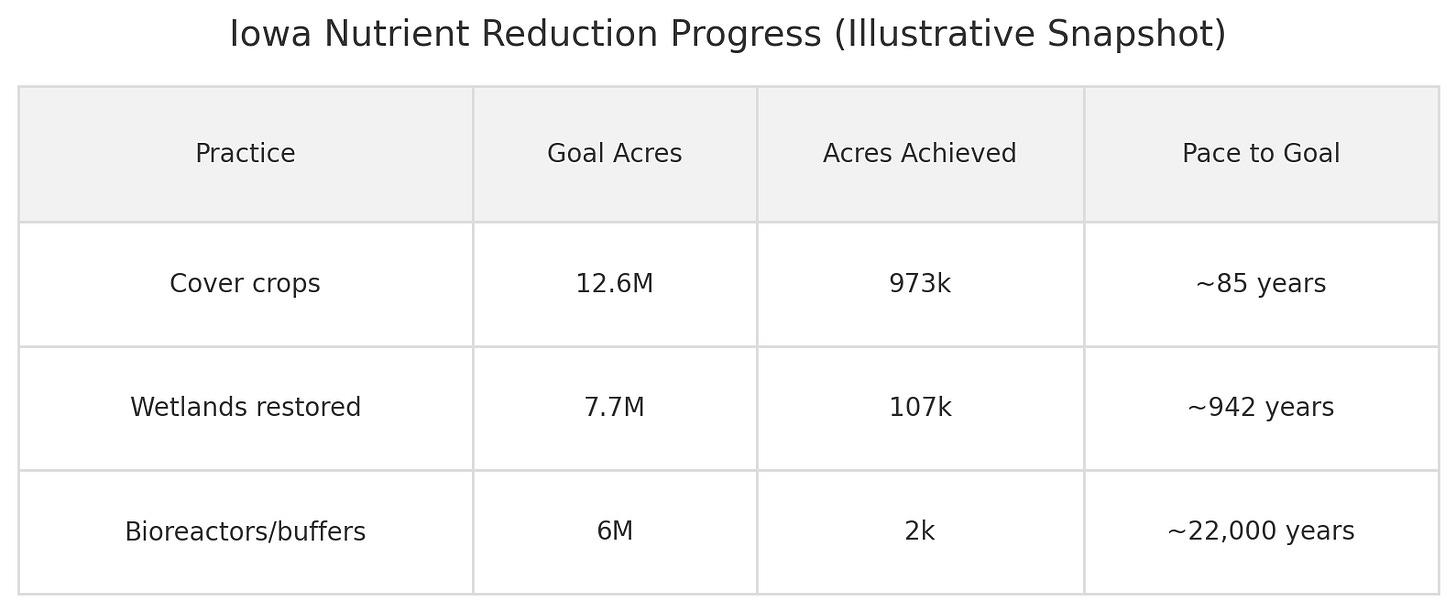Where Did the Money Go? Iowa’s Water Crisis, Corruption & Policy Failures
How industrial agriculture, vanishing funds, and political capture poisoned Iowa’s water
Quick Facts
$400,000 in outreach funds tied to a landmark water study were “zeroed out” without explanation.
Iowa’s nitrate sensor network was cut from ~80 monitors to just 20, blinding the public.
The Raccoon River spiked to 16 mg/L nitrates this summer — well above the 10 mg/L drinking water standard.
Iowa now has the second-highest cancer rate in the U.S., with hotspots linked to nitrates and pesticides.
Farm Bureau lobbies celebrated when the EPA reversed nitrate impairment designations, canceling cleanup requirements.
How We Got Here: Decades of Voluntary Failure
Back in 2013, Iowa launched its Nutrient Reduction Strategy (NRS) with the lofty goal of cutting nitrogen and phosphorus runoff by 45% by 2035. But there was a catch:
The plan was voluntary.
No numeric pollution limits.
No penalties for polluters.
Critics warned it was a fig leaf. They were right.
Progress vs. Goals (2018 snapshot):
Even as adoption ticked upward (≈4M acres of cover crops by 2023), nitrate loads in rivers barely budged.
💬 Bill Stowe, late director of Des Moines Water Works, 2013:
“This trend is absolutely off the scale… the voluntary strategy clearly isn’t working. And our ratepayers are paying significantly to remove nitrates.”
The Vanishing Funds
In 2023, Polk County invested $1M in a two-year scientific study, Currents of Change, involving 16 researchers. It confirmed what farmers and scientists already knew:
Industrial agriculture — CAFO manure + synthetic fertilizer — drives the nitrate crisis.
Health consequences include elevated risks of bladder, thyroid, ovarian, and colon cancers.
The study budgeted $400k for outreach — town halls, educational campaigns, citizen engagement. But when the findings landed, county leaders quietly erased that line item.
💬 John Norris, former county administrator:
“The intent was for a public education effort… that the public learns from it. Zeroing it out betrays that intent.”
To advocates, it was no mystery. The farm lobby wanted the report buried.
The Monitors Go Dark
For years, Iowa’s edge in this fight was data: a network of ~80 nitrate sensors in rivers statewide, maintained by University of Iowa researchers. They provided real-time nitrate maps — critical for utilities, farmers, and citizens.
In July 2025, amid record spikes, the state cut funding. Sensors dropped to 20 active sites.
💬 Carolyn Raffensperger, environmental health advocate:
“Every single data point is a measure of suffering. Cutting monitors is blinding the public to the harm.”
At public forums, Iowans booed officials when they announced the cuts. Citizens understood: the state would rather hide the problem than solve it.
The Human Toll
Rural wells: A third of private wells in farm counties test positive for nitrates; many exceed the legal limit. Families without money for reverse osmosis systems are stuck.
Public systems: Only 4% of Iowa’s municipal water systems have nitrate removal. Utilities like Des Moines Water Works spend millions to blend or strip out pollution.
Health costs: Studies link even 5 mg/L nitrates (half the legal limit) to cancers and birth defects. Roughly 7.4% of Iowans on public systems have faced exposures ≥5 mg/L in the past decade — with rates higher among low-income families, kids, and communities of color.
Cancer crisis: Iowa’s cancer registry reports the second-highest incidence in the nation, one of only two states where rates are still climbing.
💬 Angela Connolly, Polk County Supervisor:
“I truly believe there is something in the water. My daughter-in-law, 47, had breast and colon cancer. Several neighbors are sick. We need action.”
Big Ag’s Grip
The Iowa Farm Bureau and pork/corn lobbies have perfected a playbook:
Push voluntary measures, block mandates.
Celebrate token conservation progress.
Attack lawsuits (like the 2015 Water Works case) as “anti-farmer.”
Pressure regulators — as when the EPA reversed impairment listings in 2025, sparing rivers from cleanup.
When meatpackers or co-ops are caught dumping ammonia or manure, fines are tiny ($50k) and compliance deadlines years away. The message? Polluting pays.
💬 Farmer Seth Watkins, at the Des Moines forum:
“It would be great if we could do this voluntarily. But I don’t know any society in the history of mankind that protected its natural capital without enforceable regulation.”
Policy Crossroads
At stake in 2025:
Farm Bill: Will Congress expand conservation funding — or slash $16B in climate-water funds to cover tax cuts?
PERMIT Act: Pending bills could exempt more farm runoff and pesticides from Clean Water Act permits.
Local control: Counties want authority to block CAFOs in vulnerable watersheds; state leaders resist.
Advocacy priorities:
Restore nitrate monitoring and publish real-time dashboards.
Tie subsidies/crop insurance to proven nitrate-reducing practices.
Reinstate federal impairment listings and enforce cleanup plans.
Empower counties to protect aquifers and rivers.
The Resistance Grows
On August 4, 2025, 800 people packed an auditorium in Des Moines, with 400 more online. They cheered calls for new farm regulations and booed news of sensor cuts. Volunteers signed up for nitrate monitoring. Free test kits were handed out.
💬 Adam Shriver, Drake University:
“People want a course correction. They’re tired of being told, ‘everything is fine.’”
Grassroots groups like Nishnabotna Water Defenders are training neighbors to test and file pollution reports. Farmers in Practical Farmers of Iowa are backing cover crops, prairie strips, and diversified rotations. A movement is forming — one rooted in sovereignty and survival.
References
The Guardian (Aug 30, 2025). A report tied Iowa’s water pollution to agriculture. Then the money to promote it mysteriously disappeared.
Investigate Midwest / The New Lede (Aug 8, 2025). Outrage in Iowa: Residents demand action to clean up dangerously polluted water.
Associated Press (July 2025). Near-record nitrate levels force first-ever lawn watering ban for 600,000 residents in Des Moines.
Axios Des Moines (July 30, 2025). Nitrate levels of concern found in Iowa drinking water below federal limit.
Iowa Environmental Council (Apr 22, 2025). 7.4% of Iowans exposed to elevated nitrate levels — disproportionate impacts by income and race.
State Health Registry of Iowa (2024–2025 reports). Iowa cancer rates now second-highest in the U.S.
Bleeding Heartland (May 13, 2013). Record nitrate levels are wake-up call on Iowa water.
Polk County “Currents of Change” Study (2023). Two-year scientific report linking agriculture to nitrate and pesticide contamination.
Land Stewardship Project (July 1, 2025). Congress proposes $16B conservation cuts in new farm bill.
Iowa Capital Dispatch (Feb 7, 2025). Iowa updates its strategy to reduce nutrient runoff.
University of Iowa IIHR Hydroscience & Engineering (2023–2025). Nitrate sensor network and nutrient load data.



